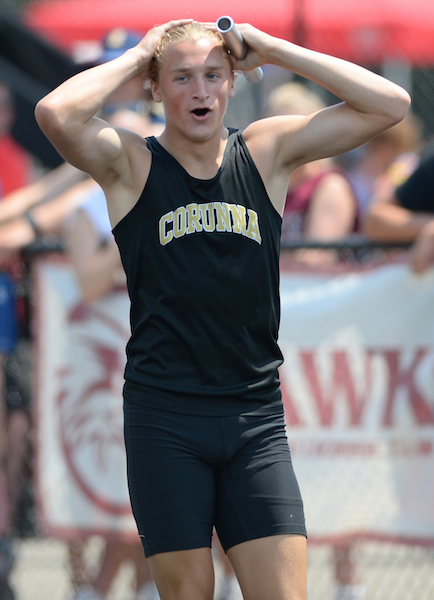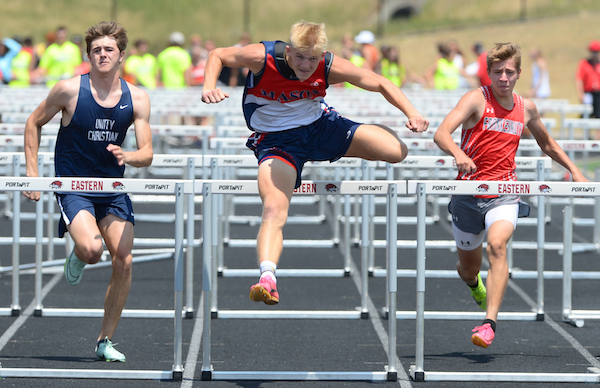
LP Division 3 Champs Take Winning Steps
June 4, 2016
By Jeff Chaney
Special for Second Half
COMSTOCK PARK – In track and field, the difference between an MHSAA Finals championship and not being atop the medal stand may be the difference of a step or two.
Marlette's Andrew Storm proved that Saturday at the Lower Peninsula Division 3 Finals at Comstock Park High School.
Two tweaks to his technique paid huge dividends, as Storm won both the 110- and 300-meter hurdles with times of 14.82 and 39.14 seconds, respectively.
"I eliminated a step from my block and found a lot of new drills that helped me win the 110," said Storm, who will take his talents to Oakland University next year. "Then in the 300, I eliminated two steps from that race, which really helped me."
Both were personal-best times, and they could not have come at a better time.
"All year I have been tweaking my runs, and I progressively got better," Storm said. "I didn't hit the first hurdle today in the 110, because I planted the first hurdle at Regionals, and that's why I was not seeded first today in that event. It really comes down to that."
The Sanford-Meridian 400 relay of Monte Petre, Andre Smith, Miles Leviere and Christian Petre set a meet record with a great time of 43.14. That group effort helped the team win its second MHSAA title in three years with 39 points, five more than runner-up Hillsdale.
"This was a group effort," Christian Petre said. "Everyone has put in the work, and we ran a smooth relay. We were peaking at the right time."
"We knew the 4X100 was going to be our strength coming in, and they set a goal of breaking a state record earlier this year and they accomplished that," Sanford-Meridian coach Mike Bilina added. "The kids work really hard, they buy into the weight room and really enjoy improving."
The Sanford-Meridian 800 relay team of Monte Petre, Matt Hoffman, Leviere and Christian Petre also won with a time of 1:29.21, while Christian Petre took second in the 100 and 200 and Monte Petre took sixth in the 100.
The Mustangs’ finish was not a huge surprise. But another thing great about sports is that anybody can have the day of his or her life and make a name just like that.
That's what happened to Wyoming Lee sophomore Thomas Robinson, as he won both the 100 and 200 with times of 11.09 and 22.2 seconds, respectively.
What makes Robinson's story so special is that he did not even play a sport his freshman year, but decided to go out for football this year and played both wide receiver and cornerback.
And after a little nudging from former Lee football coach Carlton Brewster, Robinson decided to go out for track as well.
"Coach said this would help me out for football, and I think it will," Robinson said. "I did expect to win the 200, but never thought I could win the 100, because I was seeded sixth coming in."
An athlete used to the spotlight was Grand Rapids West Catholic senior thrower Carl Myers.
Myers came into Saturday's Finals as the reigning champion in the shot put, looking to break the meet record that Allendale's Zack Hill earned with an impressive toss of 63 feet, 9.5 inches in 2009.
Myers came up short of that, but won his second shot put title with a personal-best throw of 62-9.75. He also won the discus title with a throw of 172-1.
"Of course my goal was to break the record, but I'm happy to get the wins," said Myers, who will be going to the University of Michigan next year to play football and throw the shot put. "My whole team worked hard this year, and it paid off."
PHOTO: Marlette's Andrew Storm (right) clears a hurdle on the way to one of his two individual titles Saturday at Comstock Park. (Click to see more from HighSchoolSportsScene.com.)

Vicksburg's Wright, Corunna Right On in Claiming LPD2 Championships
By
Steve Vedder
Special for MHSAA.com
June 3, 2023
ADA – If Michael Wright was a baseball player, he probably would've been called out on strikes a year ago.
Instead, the Vicksburg senior can celebrate after winning the 200 at Saturday's Lower Peninsula Division 2 Track & Field Finals at Forest Hills Eastern.
The road to the championship in the 200, via a time of 21.72, was anything but a straight line for Wright. An aspiring baseball player, he was cut from the Vicksburg squad as a freshman. His football career, by Wright's own admission, was "on and off." And then a year ago in his first track meet, Wright suffered a leg injury that virtually ended his season. He did return to finish fifth in the 200 at Finals while helping the 400 relay team to a 16th place.
So there is nothing to realistically explain how Wright found himself in the position Saturday at sweltering Forest Hills Eastern to win a championship. Except for returning this season to break the school record in the 200 four times in two months. Well, that and willpower and simple desire.
 "I knew I could finish high, maybe in the top five. But this is better," said Wright, who credits drinking large quantities of milk for his resurgence. "I looked to football because I didn't think I could bounce back for track. But I overcame the bumps, the obstacles."
"I knew I could finish high, maybe in the top five. But this is better," said Wright, who credits drinking large quantities of milk for his resurgence. "I looked to football because I didn't think I could bounce back for track. But I overcame the bumps, the obstacles."
While Wright was jump-starting his track career, Corunna won the team title with 41 points. Mason and Forest Hills Eastern tied for second with 35. Whitehall was fourth with 33 points, and Frankenmuth fifth with 29 points.
Corunna coach Jeff Sawyer, who had never won a Finals title in 37 years coaching at Owosso and three more at Corunna, said the championship came after little fanfare during the season. Virtually right up until the time Corunna hauled off its first-place trophy, Sawyer said it was never really on his team's mind. The title came after the team managed only a runner-up finish at the Regional.
"We kind of low-keyed it," he said. "We knew scoring 40 points was possible. We lost to Frankenmuth by one point at the Regional. … We were a little disappointed we didn't win, but we had some good times today. We knew it was possible.
"Every day we just come and do what we do. We talk about getting better every day with PRs (personal records). And we're still getting better because we have some tough guys. Just competitive, tough kids. But we were the underdogs."
Corunna had only two firsts on Saturday, in the 400 relay (42.63) and Wyatt Bower in the long jump (22-8½).
Among the individual highlights was Frankenmuth senior Dalton DeBeau, who successfully defended his Finals title in the discus (171-6). He was fifth in that event as a sophomore and after winning a year ago, was considered a good bet to repeat.
"I kind of expected it," said DeBeau, who will compete at Michigan State next spring. "There wasn't a lot of pressure. I knew what had to be done. I threw 160 feet on my first throw to get in the finals, and that helped right away. I knew I could go all out."
 Berrien Springs' Jake Machiniak won the 100 (10.54) while the team also captured the 800 relay (1:28.18). Machiniak said his season hasn't been without its share of difficulties. There was a time when he couldn't seem to come out of the starting blocks smoothly. But beginning with the conference meet where he ran school record 10:73, Machiniak felt himself back on course.
Berrien Springs' Jake Machiniak won the 100 (10.54) while the team also captured the 800 relay (1:28.18). Machiniak said his season hasn't been without its share of difficulties. There was a time when he couldn't seem to come out of the starting blocks smoothly. But beginning with the conference meet where he ran school record 10:73, Machiniak felt himself back on course.
"There were ups and downs. I struggled in the middle of the season," he said. "But my teammates helped me through some difficulties. I came here to finish the job; I knew I could do something here."
Mason's Tyler Baker won the 100 hurdles (14.63) to complete a long journey that included finishing just ninth in last year's prelims. The success was as simple as putting in loads of offseason work.
"I practiced and did stuff about every day," he said. "I might not be the fastest, but I make up for that in form. It's a fine-tuning thing. Everyone wants to be faster."
Mason also got a championship from A.J. Mantel, who captured the 300 hurdles (38.90).
Among other highlights was Forest Hills Eastern senior Aiden Sullivan successfully defending a 2022 title on his own home turf. He won Saturday's 800 (1:53.92).
Adrian won the 3,200 relay (7:39.77), while Grand Rapids Christian took the 1,600 (3:24.49).
Alma had two individual winners in Michael Howey in the shot (55-08) and Jacob Dunlap in the high jump (6-7).
The other champs were Kyle Eberhard of Linden in the 1,600 (4:14.79), Whitehall's Trannon Ayler in the 400 (48.83), Freeland's T.J. Hansen in the 3,200 (9:11.56) and Sam Vesperman of Grosse Ile in the pole vault (15.01). Chelsea senior Jacob Nelson competed in the adaptive 100 (27.28), 200 (57.71) and shot put (6-6).
PHOTOS (Top) Vicksburg's Michael Wright celebrates after winning the 200 on Saturday. (Middle) Corunna's Tarick Bower enjoys a moment after anchoring the winning 400 relay. (Below) Mason's Tyler Baker, center, works to stay ahead in the 110 hurdles. (Photos by Dave McCauley/RunMichigan.com.)

